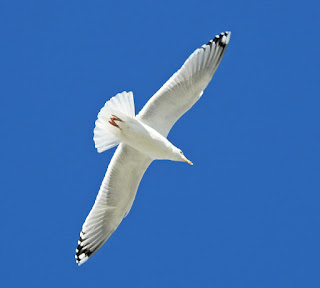** Jean-Paul and Stella LeBlanc spotted a large flock of BOHEMIAN WAXWINGS
[Jaseur boréal] north of Bouctouche on Route 11, estimating the number to be
from 1500 to 2000 individuals. When they arrived home later, 150-200 were in
their Bouctouche backyard. A flock of 25-30 CEDAR WAXWINGS [Jaseur d'Amérique]
discovered the berries of their privet hedge, cleaning up the crop. Jean-Paul
got a photo of the Cedar Waxwings accompanied by a DOWNY WOODPECKER [Pic mineur]
and EUROPEAN STARLINGS [Étourneau sansonnet] perched in the same tree, as well
as a nice close-up of a Cedar Waxwing enjoying a berry.
Stella also got a photo of a pair of PURPLE FINCHES [Roselin pourpré] at
their feeders. They also noted an adult BALD EAGLE [Pygargue à tête blanche]
near the nest located on Coates Mills Road, near Saint-Marie; it appeared to
have repairs in mind. They also spotted a vireo nest in Cocagne, seemingly still
very much intact from last year. Note the suspended pendulous character of the
nest and the building materials, including birch bark strips, that suggest a
vireo was the builder.
** Carol Steelcaptured a photo of a very unusual waxwing in her yard in Riverview. Dave Christie and Gilles Belliveau have offered
opinions to make sense of the genetics of this bird. The consensus so far is
that it is a leucistic/albinistic BOHEMIAN WAXWING [Jaseur boréal]. Albinism
suggests no melanin production whereas leucism suggests that melanin is not
produced normally. This bird has the normal wing markings of a Bohemian Waxwing,
yet has the yellow belly blush of a Cedar Waxwing, and lacks the cinnamon
undertail coverts of a Bohemian. Its size, from its position in the photo,
suggests that it is larger than the Cedar Waxwings present. Lack of melanin
production may have lead to the yellow being exhibited on the belly and the lack
of undertail covert colour. A very confusing plumage and one that could lead to
many interpretations.
** The ORANGE-CROWNED WARBLER [Paruline verdâtre] that had been
circulating between Bob and Shirley Childs’ and Cathie Smith’s feeders in
Riverview had not been seen for several days. However, it re-appeared at
Cathie’s feeder on Saturday evening, so it is still in its chosen territory and
doing well.
** Looking at some of the recent gull photos from Brian Stone, one flight
shot of an adult HERRING GULL [Goéland argenté] nicely shows the arrangement of
the so-called windows, or mirrors, at the tip of the P9 and P10 primary
feathers, to help identify this gull in flight. Also attached is a photo of a
second-winter ICELAND GULL [Goéland arctique] and a side view of a MALLARD
[Canard colvert] x AMERICAN BLACK DUCK [Canard noir] hybrid.
Nelson Poirier
Nature Moncton
AMERICAN ROBIN. FEB. 21, 2016. BRIAN STONE
BALD EAGLE AND NEST.FEB.18,2016.JPLEBLANC
CEDAR WAXWING,STARLING, AND DOWNY WOODPECKER.FEB.19.2016.JPLEBLANC
CEDAR WAXWING.FEB.19,2016.JPLEBLANC
HERRING GULL (ADULT). FEB.19, 2016. BRIAN STONE
ICELAND GULL (2ND WINTER). FEB.19, 2016. BRIAN STONE
MALLARD-BLACK DUCK HYBRID. FEB.19, 2016. BRIAN STONE
PURPLE FINCH (MALE AND FEMALE).FEB19,2016.STELLA LEBLANC
VIREO NEST.FEB.19, 2016.JP LEBLANC
WAXWING (ALBINISTIC.LEUCISTIC BOHEMIAN WAXWING SUSPECTED) FEB 21, 2016.CAROL STEEL
WAXWING (ALBINISTIC.LEUCISTIC BOHEMIAN WAXWING SUSPECTED) FEB 21, 2016.CAROL STEEL










